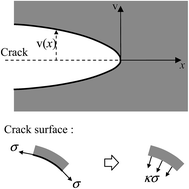The energy release rate of a pressurized crack in soft elastic materials: effects of surface tension and large deformation
Abstract
In this paper we present a theoretical study on how surface tension affects fracture of soft solids. In classical fracture theory, the resistance to fracture is partly attributed to the energy required to create new surfaces. Thus, the energy released to the crack tip must overcome the surface energy in order to propagate a crack. In soft materials, however, surface tension can cause significant deformation and can reduce the energy release rate for crack propagation by resisting the stretch of crack surfaces. We quantify this effect by studying the inflation of a penny-shaped crack in an infinite elastic body with applied pressure. To avoid numerical difficulty caused by singular fields near the crack tip, we derived an expression for the energy release rate which depends on the applied pressure, the surface tension, the inflated crack volume and the deformed crack area. This expression is evaluated using a newly developed finite element method with surface tension elements. Our calculation shows that, when the elasto-capillary number ω ≡ σ/Ea is sufficiently large, where σ is the isotropic surface tension, E is the small strain Young's modulus and a is the initial crack radius, both the energy release rate and the crack opening displacement of an incompressible neo-Hookean solid are significantly reduced by surface tension. For a sufficiently high elasto-capillary number, the energy release rate can be negative for applied pressure less than a critical amount, suggesting that surface tension can cause crack healing in soft elastic materials.


 Please wait while we load your content...
Please wait while we load your content...